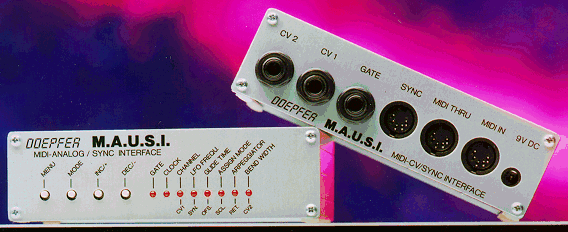
MAUSI is the combination of a MIDI-to-CV and
MIDI-to-SYNC interface to control analog vintage synthesizers, bass lines or drum machines
via MIDI provided that they are equipped with the corresponding control inputs (CV, Gate,
Sync, Clock, Start/Stop). MAUSI has 2 CV outputs, one Gate/Trigger output and one Sync
output consisting of the 2 signals Clock and Start/Stop. The control of MAUSI is done with
4 buttons and 8 LEDs at the front panel. The In- and Outputs are located at the rear
panel: three 1/4“ jack sockets for CV1, CV2 and Gate, three 5 Pin DIN sockets for
MIDI In, Out and Sync.
- CV1 : The first CV output is intended for controlling the pitch of an analog synthesizer
and has a high resolution of 12 bits (i.e. 1/64 semitone accuracy). It is controlled by
the MIDI events note on/off, pitch bend, modulation (ctr.#1) and portamento (ctr.#5 and
#65). The basic voltage is defined by the note number of an note on/off event. The events
pitch bend, modulation and portamento modify the voltage in the usual manner. The voltage
width of incoming pitch bend events is adjustable. The frequency of the internal
modulation oscillator used for modulation (ctr.#1) is adjustable and may be additionally
controlled with another MIDI controller. The portamento controllers #5 and #65 define the
glide time and glide on/off between two successive notes. The assign mode can be selected
between highest note or last note. MIDI channel and reference note for 0V CV are
adjustable. The voltage of CV1 ranges from -1V ... +6V. Scale/spread and offset of CV1 can
be adjusted via the controls at the front panel (no trimming potentiometers). The voltage
characteristic is 1V/Octave but may be set also to Hz/V with reduced functions (no pitch
bend, modulation, portamento, scale, offset).
- CV2 : The second CV output has a lower resolution of 7 bits and is intended for
controlling VCF, VCA or other functions via MIDI. CV2 may be controlled from MIDI
velocity, after touch, pitch bend or any controller. The voltage range is 0...+5V.
- Gate: The gate output can be set via jumper to +5V voltage, +U voltage (+U = voltage of
the power supply used) or switched trigger/S-trigger. The following gate functions can be
adjusted with the front panel controls: gate polarity normal/inverted, legato on/off (i.e.
new trigger yes/no when playing legato). Gate generation responds to the MIDI controllers
sustain (ctr.#64) and legato (ctr.#68) in the usual manner.
- Sync: This is a two-signal socket with the TTL compatible signals (0/+5V) Clock and
Start/Stop. The Sync connector follows the Roland Sync standard used e.g. inside TR808,
TB303. The relation between MIDI Clock and Sync Clock is adjustable as well as the
polarity of the Start/Stop signal.
MAUSI includes an external power supply for 230V AC. For other mains voltages the power
supply must be purchased by the customer in his country (7...12V DC/500mA with 2.1 or
2.5mm connector required). MAUSI is built into a light grey aluminium case (dimensions:
145 x 100 x 42 mm).
For more details you may look at the English User's Guide of MAUSI.
Price: 298.- DM
including power supply for 230V mains voltage (i.e. about 180.- US$)
Sorry. MAUSI is sold out.